Clare Rogers of Better Streets for Enfield reports back from a seminar on the low traffic neighbourhoods concept hosted by the Urban Design Group and London Living Streets.
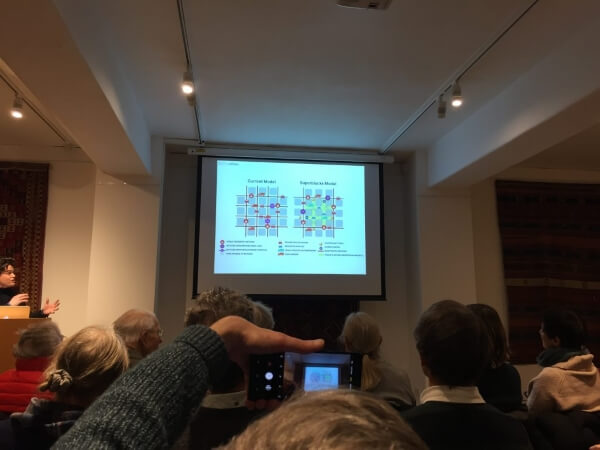
On Thursday night a number of Enfield residents and Better Streets campaigners were served up with a feast of stories, inspiration and evidence on the benefits of low traffic neighbourhoods. We were at a meeting (along with over a hundred other Londoners) hosted by the Urban Design Group and pedestrian campaigners Living Streets London. Speaker after speaker demonstrated how the LCN concept has a positive impact on everything from air quality to community.
Here are a few highlights. Please excuse the poor quality photos of the slides!
Three ingredients for a healthy city
Christopher Martin of the Urban Design Group gave a basic 3-step recipe to make cities streets human-scaled, not car-scaled, and therefore walkable, liveable and pleasant.
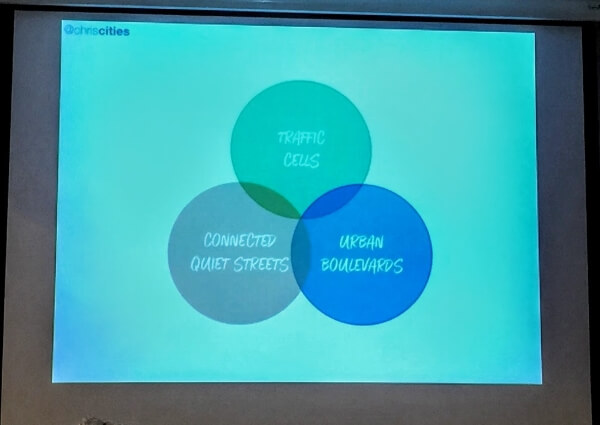
The three ingredients of a healthy city – traffic cells, connected quiet streets and urban boulevards. Slide: @chriscities
If I understood correctly: 1) ‘Traffic cells’ are low traffic neighbourhoods – where streets are access-only by car but provide direct routes for walking and cycling. Through traffic is restricted in these cells by barriers like bollards or planters. 2) ‘Connected quiet streets’ are the network of low-traffic streets that emerge when you create a number of traffic cells in a city – so that any age or ability can cycle for miles, with crossings to take you over main roads. 3) Urban boulevards are main roads that have been made people-friendly, with safe space to cycle, generous pavements, planting, seating and so on.
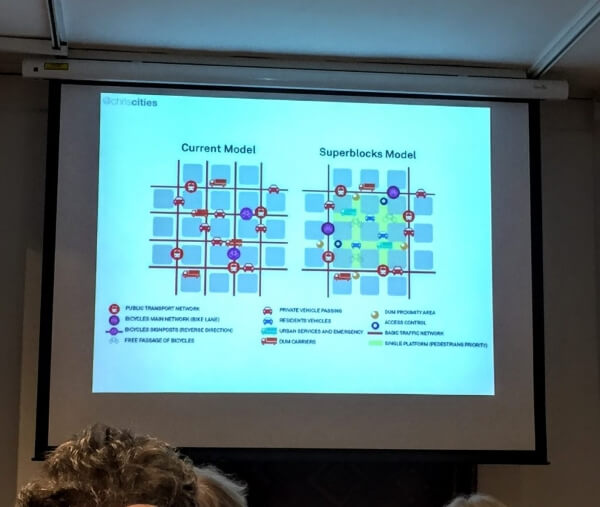
In “superblocks”, motor traffic is restricted inside the blocks to make walking and cycling easier and neighbourhoods more pleasant for people
This combination is basically what Chris Boardman is creating in Manchester through his Beelines scheme. Rather than making the odd indirect ‘quietway’ route, they are linking whole low traffic areas with crossings over main roads, meaning that anyone can cycle safely and directly from door to door. Needless to say, we would love to see that in Enfield.
Hackney leads the way
Next up was Cllr Feryal Dermici, Deputy Mayor for Hackney, who has held the council’s transport portfolio for the last ten years. Hackney stands apart in the whole country for its cycling to work statistics (15.4%). She described the borough’s cycle parking provision (400 cycle hangars so far on residential streets, with 1,000s of requests on the waiting list); low traffic neighbourhoods (114 filtered roads); ‘people parking’ (a scheme to allow residents to repurpose parking bays as mini parks); school streets (traffic bans during school run hours); and ultra-low emission streets.
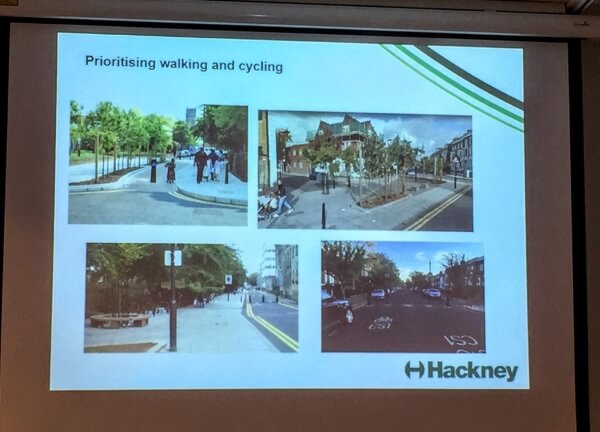
Some examples of streets in Hackney that have filtered out through traffic
How low is “low traffic”?
Then London Cycling Campaign’s Fran Graham spoke. LCC joined forces with Living Streets last year to write a guide to low traffic neighbourhoods for local councils, and this meeting was the official launch. Fran pointed out that the Mayor’s Transport Strategy goal of 70% of Londoners living within 400 metres of a safe cycle route by 2041 will be impossible to achieve without low traffic neighbourhoods. While not every road can have cycle tracks on it, many residential roads can be low in traffic – and therefore easy for anyone to ride a bike on – if rat running is removed.
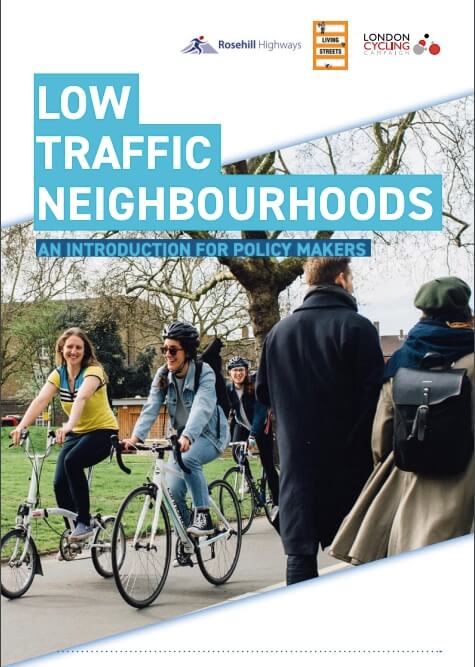
LCC have a set cut-off point above which bicycles either need to be separated from motor traffic or that traffic needs to be reduced. That point is 2,000 passenger car units (PCUs) a day. Meanwhile the Crow Manual – the Dutch street design bible – has a cut-off point of no more than 1,500 motor vehicle journeys per day (not dissimilar to 2,000 PCUs). However, in a true low traffic neighbourhood like those in Waltham Forest, where people tend to walk in the middle of the road and all-age cycling is a reality, they are seeing far less than 1,000 PCUs a day. So clearly “low traffic” means well below 1,000 motor vehicles a day – some would say about 300 maximum.
Safe routes to schools
Laurie Johnstone of Dulwich & Herne Hill Safe Routes to Schools inspired everyone in the room with her story of a campaign that has won the respect of councillors, schools and the residents alike. This group of campaigners have worked for years with 19 schools across the area, forming a coalition with other groups and tirelessly calling for safer routes and junctions and better school active travel policies. They point out that over the years, it’s the children who have been removed from our roads, not the danger. They are seeking to reverse that. They make it their business to represent children’s interests at council and public meetings, since children have no vote and parents with young families are usually too busy to take part in the political process.
We have a vision to create a community, not a drive-through
After years of seeing very little physical change on their local roads (it took 10 years to get one zebra crossing installed, for instance) they are now calling for low traffic neighbourhoods. As Laurie said, “We have a vision to create a community, not a drive-through.”
The evidence
Finally, Rachel Aldred (Transport Reader at the University of Westminster) showed how the cost-effectiveness and health benefits of low traffic neighbourhoods can be proved.
She led research on the impact of low traffic neighbourhoods in the so-called Mini Hollands, comparing “high-dose” areas (where a lot of infrastructure was already in) to “control” areas, i.e. similar outer London areas with no traffic interventions. This is a five-year study, and while she wasn’t expecting much change early on, they found that after just one year residents in Waltham Forest’s low traffic neighbourhoods were walking on average 40-45 minutes more per week than in the control areas. This may not sound much, she said, but the health benefits are huge. And there was a 20% reduction in car use!
She ran another study of just one street, Church Street in Hounslow, which had filters installed to stop through traffic. She discovered a rise in walking and cycling of 30% – which equated to £0.5 million in health benefits. Installing the filters had cost £10,000.
…and home to Enfield
These were just highlights of a rich and varied evening. It made the vision of liveable streets seem within our grasp, even in car-heavy Enfield. In fact it was clear that for any urban area with a growing population, these cost-effective, pollution-cutting, health-promoting, community-building, low traffic neighbourhoods are the only realistic way forward.
This article was originally published on the Better Streets for Enfield website.



